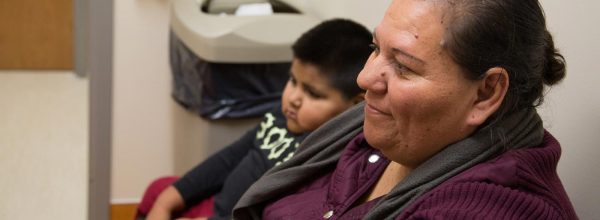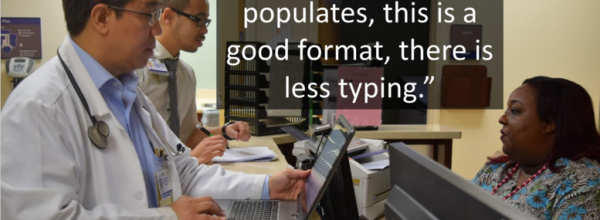The twenty-minute doctor visit is great for lots of things, but teaching patients to cope with chronic pain isn’t one of them. When the Family Medicine physicians at Riverside County Regional Medical Center wanted to improve pain care, they developed a two-hour group visit aimed at helping patients manage chronic non-malignant pain. By teaching psychological skills that supplement medication, Riverside hopes to empower patients to cope and live a life beyond their pain.
Rethinking Visits
Our modern system of primary care is designed around a unit of care¬ that doesn’t work for everything. If you have a sinus infection, an ear ache or a rash, a 20-minute doctor visit is perfect. However if a patient suffers from a chronic illness that requires constant management, this brief one-on-one window is not the most efficient or effective way to deliver care. Group visits—where several similar patients meet a provider all at the same time, usually for a longer period—have proven effective ways to provide the complex health education needed to teach patients how handle complex conditions like diabetes. Riverside County Health System decided to use the group visit model to tackle the needs of another group—patients suffering chronic pain.
Looking Beyond Medication
Our knowledge of pain is growing, but current treatments fall short for many patients. For these patients, pain can be distracting and overwhelming, making it difficult to live a normal life. Riverside wanted to offer other tools along with medications to patients with chronic pain. These behavioral, cognitive and emotional skills can supplement, but not replace, medication, giving patients a toolbox they can use to live a fuller, happier, more productive life despite their pain
How It Works
- Riverside’s family physicians brought in a pharmacist to run a pain clinic. When patients are referred to the pain clinic, an office assistant will call to invite them to a one-time group visit with a clinical psychologist.
- The group visits are held monthly. About 10-12 patients meet for two hours with the clinical psychologist in a classroom setting. Patients are free to move around or take breaks as needed. The visit is free of charge.
- Each patient who attends the group visit receives a folder containing handouts, an agenda, and an evaluation form. Patients are required to sign a confidentiality agreement and a HIPAA privacy notice form prior to the start of the visit.
- Using a handout from the American Psychological Association, the presenter explains how psychologists help patients to manage pain. This serves as a point to asking the group about expectations. Most patients in the class have pain despite taking medication, so the provider explains that the state of the art of medicine now is still not sophisticated enough to alleviate all pain.
- Because many patients with chronic pain are initially skeptical of non-medication interventions, the presenter tells the group about experiments regarding the placebo effect on pain. The goal is to help the patients understand the power of the mind and the influence of expectations on pain relief. Patients need to learn that when pain relief is expected, even a placebo can lead to relief.
- After setting the stage in this manner, patients are engaged in relaxation breathing and rhythmic counting. Getting into a relaxed state can relieve pain due to muscle tension and help patients fall asleep.. Rhythmic counting gives the brain a rest from worrying thoughts and preoccupation with pain.
- While the patients are still practicing relaxation breathing, the psychologist leads the group into a guided imagery exercise. Patients follow step-by-step instructions to use all of their physical senses to imagine and make vivid a soothing or pleasurable scene that draws attention away from pain.
- Many patients get distracted by their pain, which interrupts physical activity, mental work and even sleep. Patients learn how to take control of their mind with a one-minute mindfulness exercise called “One Stone,” adapted from the work of Millie Grenough. For one minute, each patient uses relaxation breathing while directing attention to a small stone held in the palm of the hand, noticing the details and variations of its color, shape, texture, weight. As distractions like pain draw attention away from the stone, the patient practices gentle redirection, to bring all attention back to the stone. Patients get to take home the stone they select for this skill training.
- These exercises take about the first hour of the visit. After this the class takes a break. The provider reminds patients that they can move around and change positions.
- The second hour of the class involves more patient interaction as the group discusses a series of handouts developed by Marsha Linehan for treating borderline personality disorders.
- The first of these handouts is a list of 176 “adult pleasant event” ideas for enjoying life. These include all sorts of short-term and long-term behaviors, from inner personal affirmations to playing sports or practicing karate, from planning one’s career to doodling. The list is particularly helpful for very poor patients, as it can open their mind to enjoyable activities they can do for free to distract from their pain—playing cards, solving riddles, and so forth.
- While not all of these activities are suitable for people with chronic pain, the list opens up discussion about co-morbid depression and how necessary it is to engage in pleasurable activities to counteract depression. Patients tend to notice item 52 on the list, sex, giving the presenter the opportunity to mention the National Arthritis Foundation’s material on comfortable sexual positions for patients with pain.
- The next handouts outline practices to tolerate stress and let go of emotional suffering. The group discusses steps for reducing painful emotions, and they touch on the value of finding a purpose while dealing with pain. Many patients are too disabled to work, but the presenter explains the benefits of volunteering, how making a difference in the lives of others reduces one’s own suffering. At the end the handouts patients are asked to list the pros and cons of tolerating or not tolerating pain.
- The provider ends the visit with a final handout from Linehan on distress tolerance skills, such as radical acceptance. These skills help people cope with distressing situations which can’t be changed, such as when patients experience the “breakthrough pain” that can arise before it is time for the next dose of analgesic. Distress tolerance skills can counter the sense of helplessness or the loss of control frequently reported by patients with chronic pain.
- At the end of the visit patients fill out and turn in the evaluation forms. Along with rating the class, the form asks patients what skills they plan to start using.
Best Uses, Biggest Impacts
The group visit works best for patients who suffer from chronic, non-malignant pain. The goal of the visit is to give patients coping skills they can add to their toolbox to supplement their medication. Many patients are glad to meet others who can relate to their struggles with chronic pain; some patients have exchanged phone numbers so they can support one another. Other patients use the group visit to share advice about doctors and other coping strategies, such as massage and occupational therapy. Evaluations have been overwhelmingly positive. When asked which skills they plan to start using in their daily life, most patients list relaxation breathing, guided imagery, and the “one stone” exercise.
Lessons from Practice
- Although the group visit is a one-time encounter, some patients have returned a second time because they liked the group visit so much.
- The biggest challenge of running the group visit is managing all the different personalities in the group. Even though it is a voluntary class, some patients are very stubborn and non-engaged, refusing to participate. Others will be very talkative and try to transform the visit into a personal therapy session. Skills for running focus groups can help prevent the visit from turning into a complaint session.
- Don’t be surprised if some patients nod off during the relaxation breathing exercise. Chronic pain may cause sleep deprivation. A brief review of sleep hygiene can be valuable.
- In part due to the difficulties patients have accessing transportation, Riverside found that the group visit had a 50% no-show rate.
What’s Next?
The group visits have been popular at Riverside, and as a result the system is looking to expand and enhance the program in several ways. First, the class is currently only offered in English; they are exploring ways to make it accessible to Spanish-speaking patients. Riverside is also looking at putting video versions of the pain management lessons online, to make the materials more accessible for patients who can’t or won’t come to a group visit—or simply for patients to review on their own time. Further they are considering following up with group visit participants using the texting platform Ellipsis, which Riverside’s diabetic health coaches currently use to check in with patients and offer encouragement. Finally, a committee is debating making attendance at the group visit a requirement in the pain clinic’s prescriber agreement.
Learn More
- The Riverside County Health System is composed of 10 FQHC look-alike county clinics and Riverside County Regional Medical Center.
- The “One Stone” exercise was adapted from Millie Grenough’s book OASIS in the Overwhelm: 60 Second Strategies for Balance in a Busy World, Beaver Hill Press 2005. Learn more here: http://www.milliegrenough.com/books-cds/oasis-in-the-overwhelm/
- The emotional regulation handouts were developed by psychologist and author Marsha Linehan and adapted from Skill Training Manual for Treating Borderline Personality Disorder, The Guilford Press 1993. Download these and the rest of the chronic pain group visit handouts. The packet includes:
- A HIPAA notice and confidentiality agreement.
- An evaluation form.
- A handout from the American Psychological Association on dealing with chronic pain.
- The “One Stone” exercise developed by Millie Grenough.
- “Adult Pleasant Events Schedule” listing 176 enjoyable things to do in your life, from Skills Training Manual for Treating Borderline Personality Disorder by Marsha Linehan.
- Other handouts by Linehan describing strategies for emotional regulation, reducing painful emotions, and tolerating distress.
Find this useful or interesting? We’re constantly sharing stuff like this. Sign up to receive our newsletter to stay in the loop.





